Featured, Resources, Summit Pumps
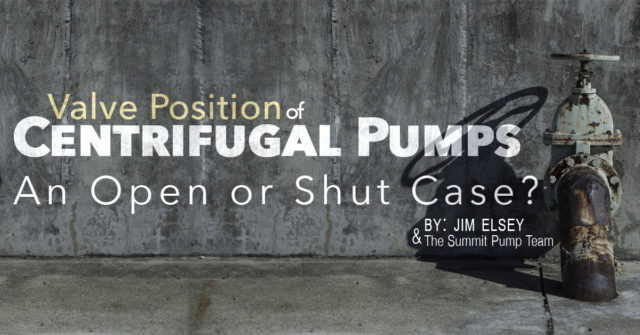
I am frequently asked; should the discharge valve be open or closed when the pump is started? My answer is….it depends, but regardless the suction valve better be open.
First Things First
Let’s look at the impeller. There are many things to consider, but the primary question we want to answer today is; what is the geometry of the impeller? From that shape we will determine the range of Specific Speed (NS). Ok, I may have lost you now because I used the nerdy “Specific Speed” term, but let me explain. Just for today’s purpose, let’s focus on the directional path of the liquid and specifically how it enters and exits the impeller.
Specific Speed is a predictive indicator for the shape of the curves for head, power and efficiency.
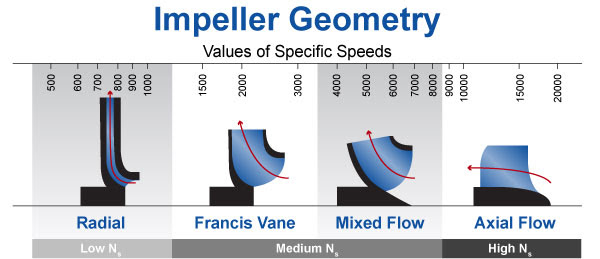
Low Ns
If the liquid enters the impeller on a path parallel with the shaft centerline and exits the impeller at an angle 90 degrees to the shaft centerline (at a right angle) then the impeller is in the low Specific Speed range. This would be a typical radial impeller like the Summit Pump model CC-FM.
Medium Ns
If the liquid enters the impeller on a path parallel with the shaft centerline and exits somewhere close to a 45 degree angle, then the impeller is in a medium Specific Speed range. These are mixed flow or Francis-Vane type impellers.
High Ns
If the liquid enters the impeller on a path parallel with the shaft centerline and exits in a path parallel to the shaft centerline, this is a high Specific Speed impeller. This axial flow type of impeller would look similar to a boat or airplane propeller.
Plan B
Don’t know the Specific Speed (Ns) of the impeller? Ask the manufacturer.
Now for the Really Interesting Part
For low Specific Speed (Ns) pumps the Brake Horse Power (BHP) required increases as you open the discharge valve and increase the flow rate, this is a direct relationship just as you would intuitively expect. For medium Ns pumps the BHP curve and its maximum point moves back to the left some nominal amount … in the past you may have not noticed this change. Axial flow pumps, of high Ns, the BHP is near its maximum point at the lower flow rates and actually reduces as the flow rate increases. Perhaps the opposite of what you would expect? Notice how the slope of the power graph also changes when the impeller design goes from low to high specific speed.

And…Answering the Original Question
I recommend that the discharge valve be closed on the startup of low Ns pumps and to be open on high Ns pumps. Note, this is a “thumb rule” and there are numerous caveats that can and will modify the answer.
- If the low Specific Speed (NS) pump is of any consequential size (Flow, Head and BHP) you may need to have the discharge valve slightly open to reduce the differential pressure across the valve. This step will minimize the effort to open the valve. Some pump systems will have a bypass line for this purpose.
- Systems that have downstream pressure (from another source) with no check valves (or check valves that are leaking by) can force the pump to spin backwards when the discharge valve is open.
- If you are starting a pump that will operate in parallel with another pump(s) you need to consider check valve lift points and controlling instrumentation (PID); this is a subject too cumbersome to explain in the “Sixty Seconds” platform.
- Normally, high Specific Speed (NS) pumps are started with the discharge valve open to reduce the electrical load and resultant stresses on the driver. In many cases the driver may not be adequately sized (on purpose) to handle the low flow power requirements and will trip offline.
-Jim Elsey
Featured, Resources, Summit Pumps
It shows that our client/customer base is becoming more sophisticated; because we see an increase in requests for performance tests. Testing is a great opportunity for us to exhibit our integrity and professionalism when our pumps are subsequently proven to meet the published performance data.
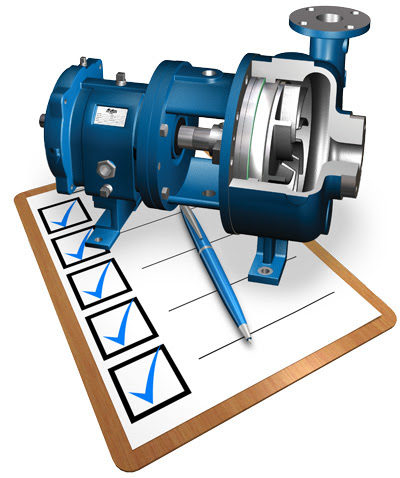
If the customer requires pump performance testing, the specific pump test and consequently the acceptable tolerances must be defined. The industry standard specification for our pumps is ANSI/Hydraulic institute 14.6-2011. But note, even within that 75 page specification there are numerous variables, detailed options and tolerance classes that remain to be defined.
The time to have the test, the delivery schedule and the subsequent costs defined is before the order is placed.
-Jim Elsey
Featured, Resources, Summit Pumps
I repeat this message annually… no, monthly. No matter the manufacturer; the majority of all pumps do NOT come from the factory ready to start up.
The pump will require oil to be added to the bearing housings.
The impeller clearance must be determined and set for the fluid temperature. The direction of rotation should be ascertained and matched to the phase rotation on the motor driver (you must do this step with the coupling removed).

The driver will need to be aligned to the pump. When I tell people that they should align their pump nine times, I get some funny looks, but allow me to explain. Yes, the alignment may have been performed in the factory, but the very second the unit was moved for transport the alignment was lost. You will need to recheck the alignment when the unit is installed and leveled, again when the base is grouted, again after the piping is installed and again after the pump has been running up to temp.
The mechanical seal will need to be set after the above steps are completed.
Finally… please understand that most manufacturers do not install the coupling at the factory because it will just need to be removed for all the above reasons.
Be ready to complete these items, so you look like a pump professional.
-Jim Elsey
Featured, Resources, Summit Pumps
Pressure and temperature boundaries are the most common violations we see in this boundary category. Don’t forget that pump suction pressure is part of the overall discharge pressure calculation.

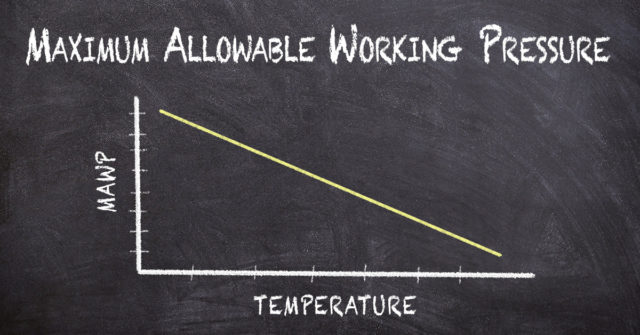
Note: Allowable pressure limits decrease with increasing temperature and not all materials have the same ratings.
If there is any doubt please consult with us. We can send you a rating chart for both 150 and 300 class flange ratings.
Do not get a ticket from the boundary police.
-Jim Elsey
Featured, Resources, Summit Pumps
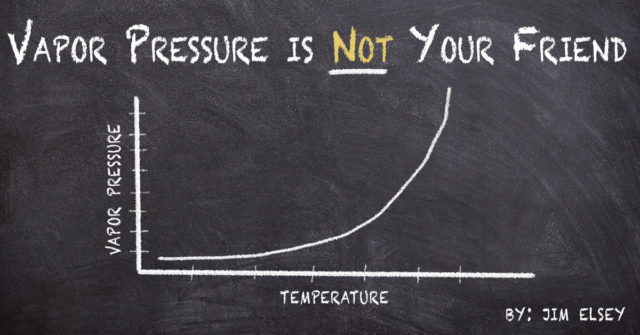
Be very careful on self-primer lift applications because the liquid temperature
directly affects its vapor pressure and that…
…changes the Net Positive Suction Head Available (NPSHA).
 Example: Self-Primer – two temperatures… two outcomes:
Example: Self-Primer – two temperatures… two outcomes:
For the example we will use two versions of the otherwise same application. The applications are identical in both versions except the temperature of the fluid is higher in the second version. The higher temperature signifies the vapor pressure has increased.
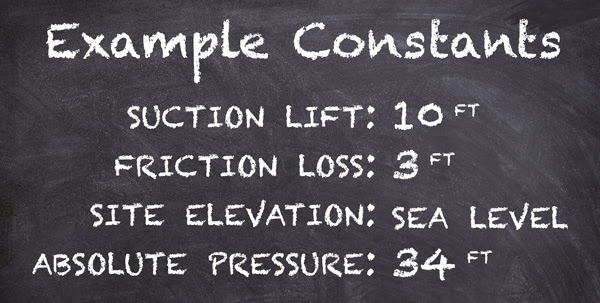
*Note: 14.7 PSI absolute atmospheric pressure x 2.31 divided by the Specific Gravity of 1 = 33.96 feet ≈ 34).
Any increase in elevation will reduce your absolute pressure (head) and consequently the NPSHA.
In Example A the fluid is water at 68ºF.
In Example B the fluid is water at 150ºF.
As you look up the vapor pressure of water for each temperature note it is normally expressed in PSIA (pounds per square inch absolute) and so you need to convert that value to feet (head) then you will have the component value in the proper units needed to do the NPSHA calculation. Remember that to convert PSI (or PSIA) to head, you must multiply by 2.31 and divide by the specific gravity.
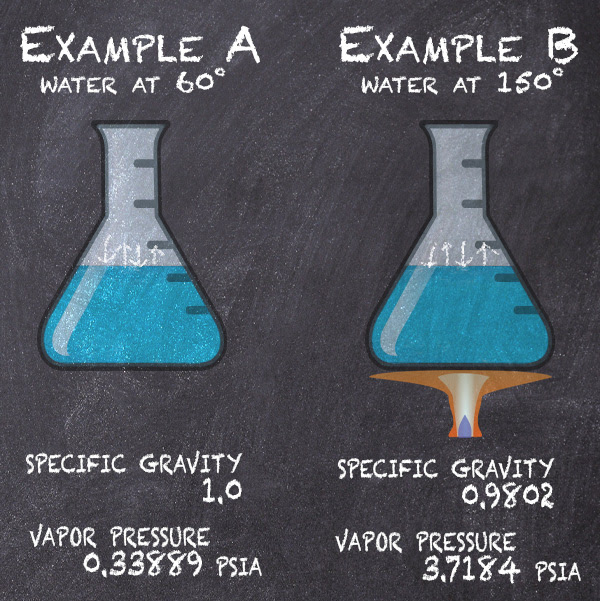
You can find these vapor pressure and specific gravity values in several places;
I use the Cameron Hydraulic Data Book or Cranes Technical Publication 410
(There are also several reputable web based sources).
Once you have the conversions then fill in the values for the formula and do the simple math steps (0.33889 X 2.31 = 0.783 ft. and 0.783 divided by 1 is 0.783). Then fill in the values in the NPSHA formula and complete the steps for the answer. Repeat these steps using the different values for Example B.

Note: The difference between the two versions for the value of NPSHA = 7.98 feet which is approximately 8 feet.
Summary: With all the parameters except temperature (vapor pressure) the same and simply changing the temperature of the fluid from 68 to 150 degrees we reduced the NPSHA by 8 feet. This may not seem like a big deal until you realize that the pump requires 13 feet of NPSHR at the condition point and now 12.24 feet is all that is available. The pump will not operate correctly and will be in a constant state of cavitation.
Corollary: Most pump manufacturers do not recommend using self–primer pumps on lift applications above 145°F for this reason. The solution for fluid temperatures above 145ºF will likely involve a vertical sump pump or a submersible pump.
-Jim Elsey
Featured, Resources, Summit Pumps

For those of us living in the northern hemisphere winter is coming and this message will serve both as a reminder and a warning as to the inevitable arrival of temperatures below freezing.
For folks like us who reside in the higher latitudes, we know from experience that at some point in time (someday soon) the temperatures will fall below freezing. Before the freezing temperatures arrive we need to take action regarding those things that could be damaged in the freezing process. Simple things like the garden hose, the swimming pool, a boat or camper, and the forgotten items in the unheated garage/shed; like a pressure washer for example.
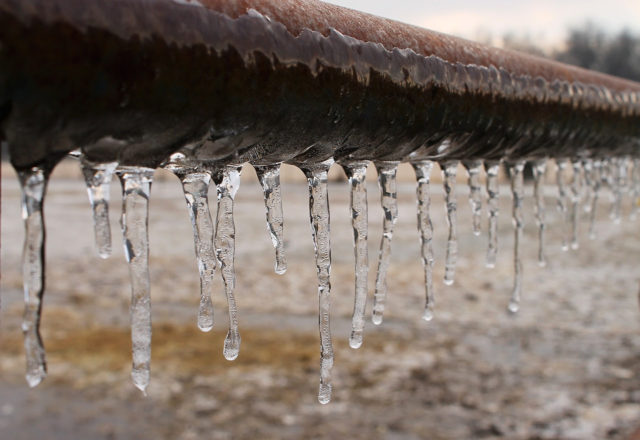
If you or your customers have a pump (and piping) that is not protected from freezing, you need to remove the water or the casing will crack and suffer expensive and permanent damage in the process. If you can’t remove the water then take steps to move the item to a protected area, add some type of anti-freeze, or add heat trace/tape.
 If you live in a more moderate climate, at lower latitudes, where it doesn’t freeze very often you may not think about these things or take any precautions. And this is also the same geographical area where we sell a lot of replacement casings when it does freeze. For some reason self-primer pumps are overlooked more often than other types. I guess because folks forget about the water in the priming chamber.
If you live in a more moderate climate, at lower latitudes, where it doesn’t freeze very often you may not think about these things or take any precautions. And this is also the same geographical area where we sell a lot of replacement casings when it does freeze. For some reason self-primer pumps are overlooked more often than other types. I guess because folks forget about the water in the priming chamber.
Did you know that water is one of the only liquids that expands when it freezes? A few solid elements expand when they freeze, but water is the essentially the only liquid that expands due to its crystalline structure. When liquid water is cooled down from standard temperatures, it contracts as you would expect until around 37 degrees F, but then as the temperature lowers below 37 degrees the water expands slightly until it reaches the freezing point. When water freezes it expands by about 9%.
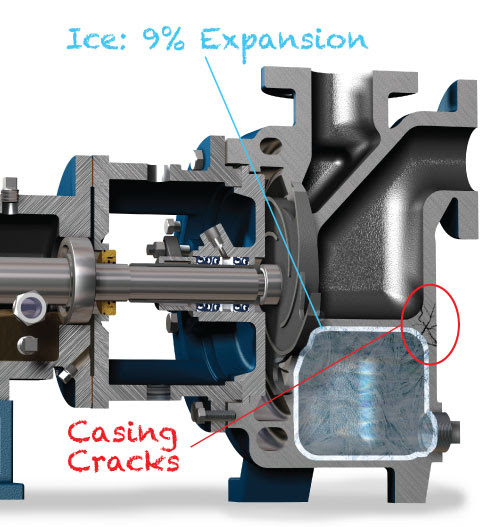
Winter is coming and the nights are long and cold. Will your pumps be ready?
-Jim Elsey



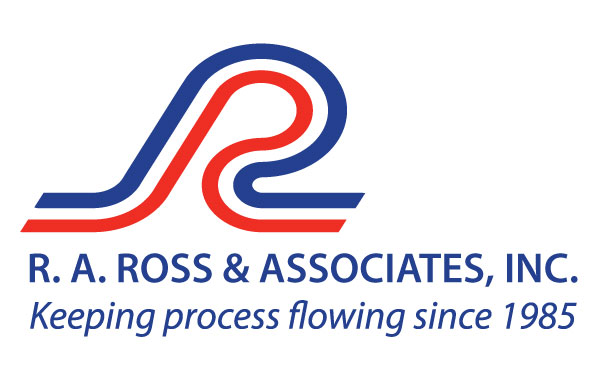









 If you live in a more moderate climate, at lower latitudes, where it doesn’t freeze very often you may not think about these things or take any precautions. And this is also the same geographical area where we sell a lot of replacement casings when it does freeze. For some reason self-primer pumps are overlooked more often than other types. I guess because folks forget about the water in the priming chamber.
If you live in a more moderate climate, at lower latitudes, where it doesn’t freeze very often you may not think about these things or take any precautions. And this is also the same geographical area where we sell a lot of replacement casings when it does freeze. For some reason self-primer pumps are overlooked more often than other types. I guess because folks forget about the water in the priming chamber.